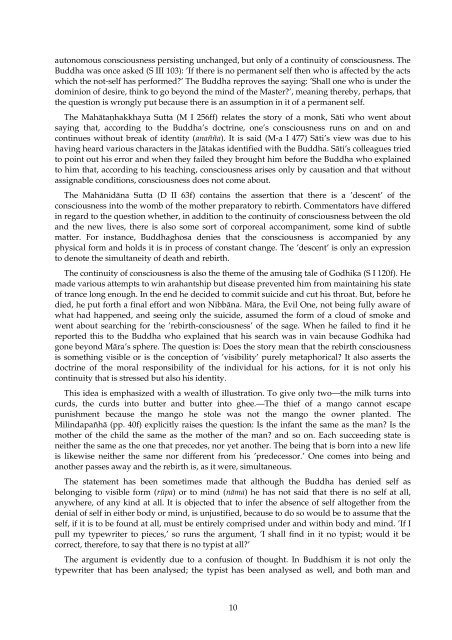The Truth of Anatta - Buddhist Publication Society
The Truth of Anatta - Buddhist Publication Society
The Truth of Anatta - Buddhist Publication Society
Create successful ePaper yourself
Turn your PDF publications into a flip-book with our unique Google optimized e-Paper software.
autonomous consciousness persisting unchanged, but only <strong>of</strong> a continuity <strong>of</strong> consciousness. <strong>The</strong><br />
Buddha was once asked (S III 103): ’If there is no permanent self then who is affected by the acts<br />
which the not-self has performed’ <strong>The</strong> Buddha reproves the saying: ’Shall one who is under the<br />
dominion <strong>of</strong> desire, think to go beyond the mind <strong>of</strong> the Master’, meaning thereby, perhaps, that<br />
the question is wrongly put because there is an assumption in it <strong>of</strong> a permanent self.<br />
<strong>The</strong> Mahātaṇhakkhaya Sutta (M I 256ff) relates the story <strong>of</strong> a monk, Sāti who went about<br />
saying that, according to the Buddha’s doctrine, one’s consciousness runs on and on and<br />
continues without break <strong>of</strong> identity (anañña). It is said (M-a I 477) Sāti’s view was due to his<br />
having heard various characters in the Jātakas identified with the Buddha. Sāti’s colleagues tried<br />
to point out his error and when they failed they brought him before the Buddha who explained<br />
to him that, according to his teaching, consciousness arises only by causation and that without<br />
assignable conditions, consciousness does not come about.<br />
<strong>The</strong> Mahānidāna Sutta (D II 63f) contains the assertion that there is a ’descent’ <strong>of</strong> the<br />
consciousness into the womb <strong>of</strong> the mother preparatory to rebirth. Commentators have differed<br />
in regard to the question whether, in addition to the continuity <strong>of</strong> consciousness between the old<br />
and the new lives, there is also some sort <strong>of</strong> corporeal accompaniment, some kind <strong>of</strong> subtle<br />
matter. For instance, Buddhaghosa denies that the consciousness is accompanied by any<br />
physical form and holds it is in process <strong>of</strong> constant change. <strong>The</strong> ’descent’ is only an expression<br />
to denote the simultaneity <strong>of</strong> death and rebirth.<br />
<strong>The</strong> continuity <strong>of</strong> consciousness is also the theme <strong>of</strong> the amusing tale <strong>of</strong> Godhika (S I 120f). He<br />
made various attempts to win arahantship but disease prevented him from maintaining his state<br />
<strong>of</strong> trance long enough. In the end he decided to commit suicide and cut his throat. But, before he<br />
died, he put forth a final effort and won Nibbāna. Māra, the Evil One, not being fully aware <strong>of</strong><br />
what had happened, and seeing only the suicide, assumed the form <strong>of</strong> a cloud <strong>of</strong> smoke and<br />
went about searching for the ’rebirth-consciousness’ <strong>of</strong> the sage. When he failed to find it he<br />
reported this to the Buddha who explained that his search was in vain because Godhika had<br />
gone beyond Māra’s sphere. <strong>The</strong> question is: Does the story mean that the rebirth consciousness<br />
is something visible or is the conception <strong>of</strong> ’visibility’ purely metaphorical It also asserts the<br />
doctrine <strong>of</strong> the moral responsibility <strong>of</strong> the individual for his actions, for it is not only his<br />
continuity that is stressed but also his identity.<br />
This idea is emphasized with a wealth <strong>of</strong> illustration. To give only two—the milk turns into<br />
curds, the curds into butter and butter into ghee.—<strong>The</strong> thief <strong>of</strong> a mango cannot escape<br />
punishment because the mango he stole was not the mango the owner planted. <strong>The</strong><br />
Milindapañhā (pp. 40f) explicitly raises the question: Is the infant the same as the man Is the<br />
mother <strong>of</strong> the child the same as the mother <strong>of</strong> the man and so on. Each succeeding state is<br />
neither the same as the one that precedes, nor yet another. <strong>The</strong> being that is born into a new life<br />
is likewise neither the same nor different from his ’predecessor.’ One comes into being and<br />
another passes away and the rebirth is, as it were, simultaneous.<br />
<strong>The</strong> statement has been sometimes made that although the Buddha has denied self as<br />
belonging to visible form (rūpa) or to mind (nāma) he has not said that there is no self at all,<br />
anywhere, <strong>of</strong> any kind at all. It is objected that to infer the absence <strong>of</strong> self altogether from the<br />
denial <strong>of</strong> self in either body or mind, is unjustified, because to do so would be to assume that the<br />
self, if it is to be found at all, must be entirely comprised under and within body and mind. ’If I<br />
pull my typewriter to pieces,’ so runs the argument, ’I shall find in it no typist; would it be<br />
correct, therefore, to say that there is no typist at all’<br />
<strong>The</strong> argument is evidently due to a confusion <strong>of</strong> thought. In Buddhism it is not only the<br />
typewriter that has been analysed; the typist has been analysed as well, and both man and<br />
10

















